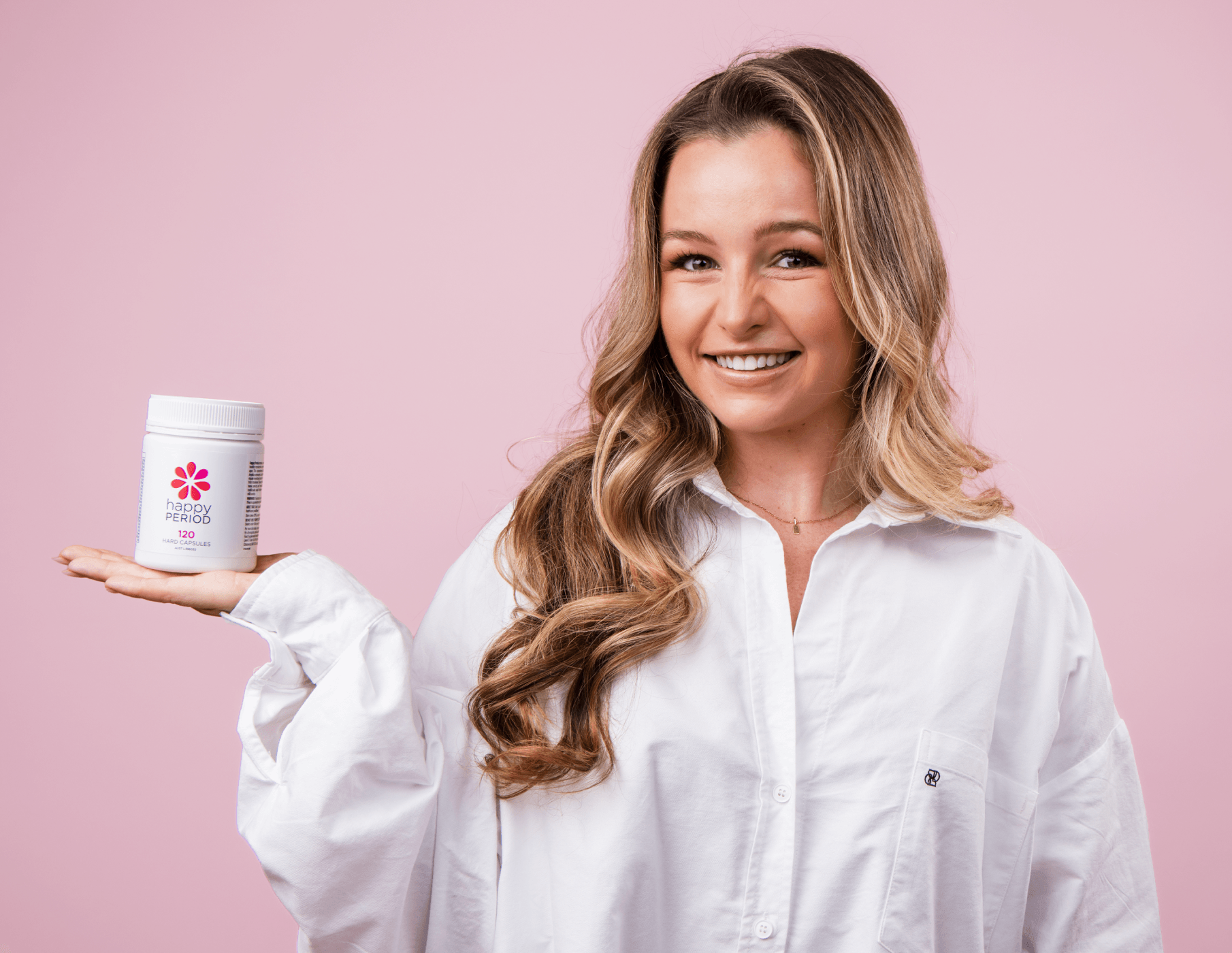What is Happy Period and Who Can It Support?
By Renee Grandi

If you’re experiencing painful periods, PMS, heavy, prolonged periods, premenstrual dysphoric disorder (PMDD), facial hair, absent periods, periods over 35 days, hair loss, anxiety, chronic stress, period clots, blood sugar dysregulation, and infertility — our Happy Period herbal formula is the one for you.
The herbs in Happy Period have been specifically designed to enhance female reproductive functions, nourish the ovaries, reduce sugar cravings, improve circulation, metabolism, and everything in between.
Here’s a breakdown of the herbs’ therapeutic functions, so you can understand why we love this formula so much!
Angelica polymorpha (Dong quai)
Dong quai is known traditionally as "empress of the herbs," "sovereign herb for women," and "the female ginseng." It’s renowned for supporting the female reproductive tract and reducing pelvic and abdominal pain. In addition, dong quai activates healthy blood circulation within the uterine lining, intestines, and brain.
Research concludes strong evidence in supporting the treatment of:
- Migraines
- Headaches
- Chronic pelvic pain
- Neuralgia and arthralgia
- Menstrual disorders (absent periods, heavy periods, blood clots, abdominal pain, abnormal menstruation)
- Tinnitus (ringing in the ears)
- Constipation
- Immunity
- Skin conditions (acne, eczema, dermatitis, psoriasis or rash prone)
It’s ideal for those with chronic pelvic inflammatory disease, endometriosis, adenomyosis, PCOS and skin conditions, too. Dong quai works on your DNA by improving antioxidant pathways for enhanced Nrf2 mRNA and protein expression. Additionally, Dong quai can decrease the levels of proinflammatory cytokines, such as TNF-a and IL-1b, and proinflammatory mediators.
Not only is Dong quai badass for period pain; its ability to reduce pain is said to be 1.7 times greater than that of aspirin.

Paeonia lactiflora & Glycyrrhiza glabra (Licorice root) combination
This is one potent combination for PCOS and female reproductive health. It’s a real winner for those experiencing hair loss, facial hair, acne, anxiety, depression, and missed/late periods.
The paeonia and licorice root combo has been shown to:
- Significantly reduce serum-free and total testosterone levels
- Normalise menstrual cycles
- Improve heavy and painful periods
- Reduce serum androgen levels in women (including DHEA/DHEAs) which are key hormones dysregulated in PCOS or chronic stress
- Improve healthy ovulation
- Reduce androgen (male hormone) flares
- Improve health LH:FSH levels (you can read more about ‘What causes PCOS?’ here)
- Improve Sex Hormone Binding Globulin (SHBG) which ensures you have healthy blood hormone levels

Panax Notoginseng (Panax ginseng)
Panax ginseng is a fabulous adaptogenic herb that is acclaimed for significantly improving:
- Vitality
- Stamina and endurance
- Physical performance
- Glucose metabolism
- Circulation
- Mental clarity, memory recall, attention and stress adaptation
- Immune modulation (balancing a heightened immune response or increasing lowered immunity)
- Superior protective effects on the cerebrovascular system
- Pain
It’s been used for thousands of years in traditional Chinese medicine and modern medical research demonstrates ginseng provides liver-protective, anti-inflammatory, antioxidant, lipid-regulatory, neuroprotective, anti-vascular disease, and renoprotective effects.
It has the actions to dissipate blood stasis, stop bleeding, promote blood circulation and alleviate pain.

Asparagus racemosus (Shatavari)
Stress and high cortisol are major negative influences on hormonal health and reproductive imbalances in today's world. Shatavari can improve female reproductive health complications, including hormonal imbalances, polycystic ovarian syndrome (PCOS), follicular growth and development, oocyte quality and infertility.
It’s a powerful female tonic herb that has been used for thousands of years to gracefully support:
- Hirsutism, facial hair and acne
- Physical and psychological health
- Amenorrhea (absent periods) or prolonged cycle lengths
- Period pain
- Anovulation (lack of healthy ovulation)
- PMS
- Fertility and conception rates
- IVF and miscarriages
- Libido
- Hormonal balancing postpartum
- Anxiety and heightened chronic stress responses
- Depression
- Increasing lactation (breast milk)
When overcoming stress-mediated reproductive health disorders in women, Shatavari is a winner. Shatavari aids in correcting pituitary gland functions/communications and promotes healthy cellular growth, differentiation and physiological functions within the female reproductive system.

Gymnema Sylvestre (Gymnema)
If you’ve got a sweet tooth or are prone to craving all of the carbs, this herb can do WONDERS. Gymnema is all about supporting metabolism, blood sugar regulation, sugar/carb cravings and bacterial infections. Perfection for those prone to binge eating, excessive snacking, PCOS, insulin resistance, high cholesterol, and type 2 diabetes.
Time and time again, Gymnema sylvestre extract has been shown to improve:
- The regeneration of the pancreas, liver, and kidneys
- Obesity and weight maintenance
- Sugar cravings
- PCOS weight gain
- Inflammation
- Digestion and underlying bacterial infections like candida albicans
- Type 2 diabetes
- High cholesterol
Gymenma sylvestre is known as the ‘Sugar Destroyer’.
Gymnema promotes the regeneration of pancreatic islet cells and insulin secretion and has been shown to selectively suppress taste responses to sweet compounds without affecting the perception of other taste elements. This taste modulation has given Gymnema Sylvestre the reputation of being a “sugar destroyer”.

Lepidium meyenii (maca root)
In the Inca Empire, the warriors ingested the maca in advance of battle to enhance their energy to assault their enemies. It was also traded as a currency due to its potent medicinal properties. Maca root is a distinguished herb to therapeutically improve:
- Libido
- Orgasms in post-menopausal women
- Anaemia
- Female hormone imbalances
- Fertility
- High levels of testosterone
- Stamina and physical endurance
- Chronic fatigue
- Memory and cognition
- Menopausal signs and symptoms
Maca root stimulates the endocrine glandular system and acts as a natural hormonal balancer. It helps to synergistically regulate oestrogen and progesterone, encouraging a healthy menstrual cycle. It is an adaptogen and an incredible fertility superfood.
Trifolium pratense (Red clover)
Red clover is a phytoestrogen that helps to BALANCE oestrogen levels, meaning, if oestrogen is high, it will be reduced; if it is low, it will be increased—proving significant importance in balancing women's hormones.
Red clover displays potent benefits for:
- Antioxidant and anti-cancer effects
- Cardiovascular function
- Blood glucose and cholesterol support
- Various tissues including endometrium, breast, skin and reproductive system
- Acne and inflammatory skin conditions
- PCOS
- Poor liver detoxification
It’s pretty amazing and nurturing in a multitude of ways for all things female-related!

Dioscorea villosa (Wild yam)
You may have heard of this one as a progesterone cream because it contains diosgenin, a precursor to progesterone, oestrogen, and steroidal drugs in the pharmaceutical industry.
Wild yam has outstanding research regarding its therapeutic potential, supporting:
- Painful and heavy periods
- Infertility and threatened miscarriage
- PCOS and ovarian pain
- Menopause and associated signs/symptoms
- Healthy and glowing skin
- Chronic inflammation, particularly within the reproductive tract and breast tissue
Research has also revealed diosgenin enhances DNA synthesis of skin and restoration of keratinocyte proliferation in aged skin. So what doesn't this lovely yam do?
Taraxacum officinale (Dandelion root)
Another totally amazing herb for women's health in sooo many different ways! Research has shown dandelion root to:
- Significantly improve bile flow and liver detoxification
- Cleanse the liver of excessive hormones
- Increase SHBG to reduce free testosterone (great for PCOS!)
- Remove toxins and cleanse the blood
- Treat various bacterial infections
- Aid in healthy digestion, e.g., reduce bloating, diarrhoea, intestinal cramping, constipation, and gas
- Reduce gastric ulcers
- Support the breakdown of proteins and fats
- Promote healthy digestive bacteria
Dandelion root has been shown to reduce inflammatory liver enzymes ALT and AST and increase the liver free radical scavenging activity.
All in all, dandelion root has got some profound healing properties. It’s an excellent immunomodulator (immune balancer) and has even been shown to support ovarian granulosa cells and their receptor site activity.

Melissa officinalis (Lemon balm)
When thinking of lemon balm, think; calming, soothing, and immune boosting. It’s loaded with potent antioxidant compounds and has been used traditionally and in the modern herbal world for:
- Reducing gas, flatulence, bloating, nausea, and digestive discomfort
- Soothing the nervous system and nervous tension
- Improving pain
- Reducing fevers, bacterial, viral, and fungal infections (including herpes simplex infections)
- Recurring headaches
- Amenorrhoea
- Libido, sexual desire, arousal, and lubrication for women with low libido
- Vertigo
- Insomnia
If you have questions about if Happy Period is right for you, email our support team at support@happyhealthyyou.com.au or book a FREE 10-minute consultation in our online women’s health clinic.
REFERENCES
- Arentz S, A. J. (2014). Herbal medicine for the management of polycystic ovary syndrome (PCOS) and associated oligo/amenorrhoea and hyperandrogenism; a review of the laboratory evidence for effects with corroborative clinical findings. BMC Complement Altern Med. Dec 18;14:511.
- Liu, Q., & Li, Y. (2018). Anti-fatigue Effects of Polysaccharide from Angelica Sinensis. Materials Science and Engineering. 392 052011.
- Darvish-Mofrad-Kashani Z et al. (2018). Effect of Melissa officinalis (Lemon balm) on Sexual Dysfunction in Women: A Double- blind, Randomized, Placebo-controlled study. Iran J Pharm Res. Winter;17(Suppl):89-100.
- Debanjali, B. (2015). Pharmacological and Biochemical Action of Angelica Sinensis (Dong Quai): Natural Product with Therapeutic Potential. International Journal of Recent Research in Life Sciences (IJRRLS), 8-23.
- Dietz, B. M., Hajirahimkhan, A., Dunlap, T. L., & Bolton, J. L. (2016). Botanicals and Their Bioactive Phytochemicals for Women's Health. Pharmacological Reviews, 1026–1073.
- Kasprzak, D. et al. (2018). Lepidium meyenii (Maca) – multidirectional health effects – review. Curr. Issues Pharm. Med. Sci. Vol. 31, No. 3, 107-112.
- Fisher, C. Y., Adams, J., Frawley, J. E., Hickman, L. D., & Sibbritt, D. W. (2018). Is there a role for Western herbal medicine in treating cyclic perimenstrual pain and discomfort? Australian and New Zealand Journal of Obstetrics and Gynaecology. Feb;59(1):154-156.
- Fisher, C., Hickman, L., Adams, J., & Sibbritt, D. (2017). Cyclic Perimenstrual Pain and Discomfort and Australian Women's Associated Use of Complementary and Alternative Medicine: A Longitudinal Study. .Journal of Women's Health. Jan;27(1):40-50.
- Hartmann, G. & McEwen, B. (2018). The potential of herbal medicine in the management of endometriosis. Journal of the Australian Traditional-Medicine Society. Vol. 24, Issue 3, 146–154.
- Joshi, MS et al. (2021). Polycystic ovarian syndrome: A review covering phytoconstituents for its outstrip management. Pharmacological Research - Modern Chinese Medicine. Volume 1:100011.
- Selvaraj K et al. (2019). Asparagus Racemosus - A Review. Sys Rev Pharm. 10(1):87-89.
- Lee, H et al. (2016). Ginseng for managing menopausal womanʼs health. Medicine. Sep;95(38):e4914.
- Liu, H., Lu, X., Hu, Y., & Fan, X. (2020). Chemical constituents of Panax ginseng and Panax notoginseng explain why they differ in therapeutic efficacy. Pharmacological Research. Nov;161:105263.
- McEwen, B. (2015). The Influence of Herbal Medicine on Platelet Function and Coagulation: A Narrative Review. Seminars in Thrombosis and Hemostasis, Apr;41(3):300-14.
- Miraj, S., Kopae, M. R., & Kiani, S. (2016). Melissa officinalis L: A Review Study With an Antioxidant Prospective. Journal of Evidence-Based Complementary & Alternative Medicine. Jul;22(3):385-394.
- Mohsen, A et al. (2021). Pharmacological and therapeutic properties of the Red Clover (Trifolium pratense L.): an overview of the new finding. Journal of Traditional Chinese Medicine. Aug;41(4):642-649.
- Moini Jazani, A., Nasimi Doost Azgomi, H., Nasimi Doost Azgomi, A., & Nasimi Doost Azgomi, R. (2019). A comprehensive review of clinical studies with herbal medicine on polycystic ovary syndrome (PCOS). DARU Journal of Pharmaceutical Sciences. Dec;27(2):863-877.
- Obidiegwu, J. E., Lyons, J. B., & Chilaka, C. A. (2020). The Dioscorea Genus (Yam) - An Appraisal of Nutritional and Therapeutic Potentials. Foods. Sep 16;9(9):1304.
- Wang, T et al. (2018). Effect of Dandelion Extracts on the Proliferation of Ovarian Granulosa Cells and Expression of Hormone Receptors. Chinese Medical Journal. Jul 20;131(14):1694-1701.
- Pandey, AK et al. (2018). Impact of stress on female reproductive health disorders: Possible beneficial effects of shatavari (Asparagus racemosus). Biomedicine and pharmacotherapy. Jul;103:46-49.
- Raja, RR. (2015). Vital role of herbal medicines in womens health: A perspective review. African Journal of Plant Science. 9(8):320-326.
- Kumari, RR, Jaiswal, A, Sati, P & Pathak, R. (2019). Medicinal plants used in women's health problems. Medico-Biowealth of India. Volume IV (pp.131-140).
- Saboori, S., Falahi, E., Rad, E. Y., Asbaghi, O., & Khosroshahi, M. Z. Effects of ginseng on C-reactive protein level: A systematic review and meta-analysis of clinical trials. Complementary Therapies in Medicine. Aug;45:98-103.
- Bashir, S & Peer, LA (2022). Phytochemistry, biological properties, economic and ecological importance of Taraxacum officinale, A review. International Journal of Botany Studies. Vol. 7, Issue 2, 574-582.
- Shergis, J. L., Zhang, A. L., Zhou, W., & Xue, C. C. (2013). Panax ginseng in Randomised Controlled Trials: A Systematic Review. Phytotherapy Research. Jul;27(7):949-65.
- Soo Lee, M. (2017). The Use of Maca (Lepidium meyenii) for Health Care: An Overview of Systematic Reviews. Sustained Energy for Enhanced Human Functions and Activity. pp.167-172.
- Pachiappan, S., Matheswaran,S., Saravanan, P.P., and Muthusamy, G. (2017). Medicinal plants for polycystic ovary syndrome: A review of phytomedicine research. International Journal of Herbal Medicine. Vol. 5, Issue 2, Part B.
- Turner et al. (2020). Consuming Gymnema sylvestre Reduces the Desire for High-Sugar Sweet Foods. Nutrients. Apr; 12(4): 1046.
- Verma, S & Sehajpal, S. (2022). A Review on Gymnema sylvestre Pharmacognostical Profile and its Anti-hyperglycemic Activity. Systemic Reviews In Pharmacy. Volume 13, Issue 9.
- Wang, S., & Zhu, F. (2019). Chemical composition and health effects of maca (Lepidium meyenii). Food Chemistry. Aug 1;288:422-443.
- Wei, W.-L., Zeng, R., Gu, C.-M., Qu, Y., & Huang, L.-F. (2016). Angelica sinensis in China-A review of botanical profile, ethnopharmacology, phytochemistry and chemical analysis. Journal of Ethnopharmacology. Aug 22;190:116-41.
- Yang et al. (2020). Panax notoginseng for Cerebral Ischemia: A Systematic Review. The American Journal of Chinese Medicine. 48(6):1331-1351.
- Zhou, K., Zhang, J., Xu, L., & Lim, C. E. (2021). Chinese herbal medicine for subfertile women with polycystic ovarian syndrome. Cochrane Database of Systematic Reviews. (6): CD007535.








Leave a comment
This site is protected by hCaptcha and the hCaptcha Privacy Policy and Terms of Service apply.